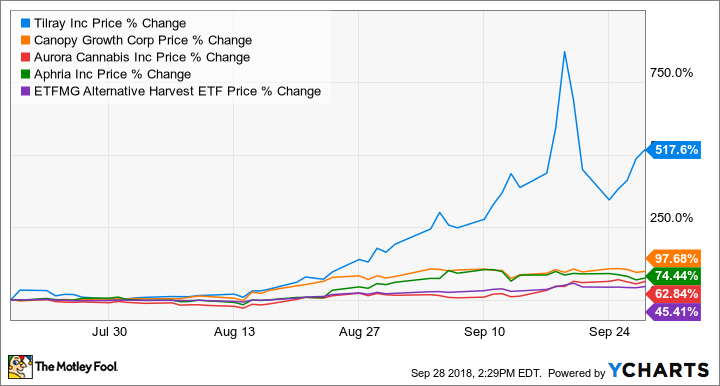Few things captivate the market like enormous returns. Such potential to "get rich quick" and the speculative behavior behind it is what usually drives market bubbles. This sentiment helped create the tech stock bubble in the late 1990s, the housing bubble of last decade, the cryptocurrency bubble last year, and now an apparent bubble in marijuana stocks.
Nowhere has this been more obvious than in the sudden growth of Tilray (TLRY +0.00%), the Canadian pot grower, which surged more than 1,000% from its $17 IPO price on July 19 to an intraday peak of $300 two months later on Sept. 19. The opportunity and excitement over Canada's legalization of recreational marijuana on Oct. 17 have propelled several marijuana stocks higher, but none more than Tilray as the chart below shows.
With that monster growth and volatility, it's no surprise everyone's talking about Tilray. We'll take a look at what's driving the volatility in Tilray, but first let's examine the greater opportunity in marijuana, as the broader sector is also attracting significant market attention.

Image source: Getty Images.
High times
Marijuana stocks have gradually gained momentum as more U.S. states have voted to legalize recreational and medical marijuana, Canada's set a date of Oct. 17 for national legalization, and American culture continues to lean toward future legalization of recreational marijuana. The legalization of pot is a unique opportunity for investors as there is a large black market for the product, which generated an estimated $46.4 billion in sales in North America in 2016, according to Arcview Market Research, or 87% of all pot sales.
Full legalization would likely make the market significantly larger, since it woud remove the legal risk of consuming marijuana and make it much easier to buy. For example, in Colorado, which legalized recreational pot in 2014, sales reached $1.5 billion last year, up 15% from the year before. Extrapolating that figure for the country as a whole would yield $87 billion in annual U.S. sales, based on Colorado's population of 5.6 million. Further, the historical growth in Colorado sales signals that future pot sales could be much larger, perhaps $200 billion or more within a decade if it were legalized nationally. That range is comparable to alcohol sales, which reached $223 billion in 2016, and tobacco sales, which were $93.4 billion that year. Tobacco in particular has been the source of massive returns; Altria was the best-performing stock on the market from 1966 to 2016, according to Wharton professor Jeremy Siegel.
That opportunity in the industry, the similarities to alcohol and tobacco, and the validation for the industry from investors like Corona distributor Constellation Brands, which took a $4 billion, 38% stake in Canopy Growth Corporation (CGC 9.16%) and Molson Coors, which formed a joint venture with Hydropothecary, both with an eye on potentially producing cannabis-infused beverages, have drawn investors in and caused pot stocks to soar.
The excitement around Tilray
Tilray was the first pure-play marijuana IPO in the U.S. and the third marijuana stock to list in the U.S. after Canopy Growth and Cronos Group. The novelty of a marijuana IPO on a U.S. exchange and a small float of just 9 million shares caused the offering to become several times oversubscribed. The small float helped push the stock higher, since there were only so many shares available to hungry investors, and a short squeeze followed as investors who bet against the stock were forced to cover their bets.
Tilray is only the fifth-largest cannabis company in Canada by production so the fact that its market cap is now larger than any of its rivals seems hard to justify. Also, almost anytime a stock surges as fast as Tilray has, the reason is mostly speculation, not any fundamental driver in the underlying asset. This seems especially true for a recent IPO like Tilray.
The stock's volatility is likely to continue at least through the Oct. 17 Canadian legalization date, but at this point, it seems hard to justify Tilray's $13 billion market cap -- even an optimistic analyst forecast only calls for $500 million in revenue by 2021, giving it a price-to-sales valuation of 26. For a company that is just one of many competitors in a fast-growing industry, that price tag is very difficult to justify.












